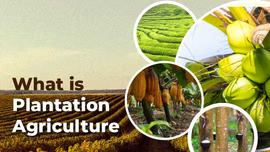
Aloe (Aloe vera) is a valuable and traditional medicinal plant from the Asphodelaceae or Liliaceae family. Its name, "Aloe vera," ('Ghrit Kumari' in Hindi), is derived from the Arabic term Alloeh, which means shining bitter stuff. Due to the growing popularity of organic and herbal goods in recent times, the demand for Aloe Vera has increased both domestically and globally. In this article, we’ll go over everything you need to know about Aloe Vera Farming in India, from its benefits, climate needs, irrigation, and harvesting. Keep reading to find out more.
Table of Content
Introduction to Aloe Vera
Aloe Vera is one of the world's oldest medicinal plants recorded in history. The first human use of the Aloe Vera plant was recorded in Sumerian hieroglyphics circa 2200 BC. Egyptians also used it extensively, describing it as a medicinal plant having properties to treat both external and internal illnesses. Aloe vera is a plant that has a combination of glucosides known as 'aloin'. Aloin, a gel compound found in the plant, is great for the skin since it has a cooling and moisturising effect, making it great for creams and lotions. The plant also contains vitamin-A, B1, B2, B6, B12, Folic Acid, and Niacin. Aloe vera-based medicines are used to treat burns, sunburn, and many other skin illnesses such as eczema, pruritus, psoriasis, and acne.
Aloe Vera is a Perennial Xerophyte plant, which means it can grow well in arid regions. It has elongated and pointed leaves that are joined at the stem in a rosette pattern. The triangular, fleshy leaves have serrated edges. A thick, green epidermal covering (skin or rind) protects the leaf. Each leaf includes three layers: The first layer is the inner clear gel layer, which contains 99% water while the remaining 1% is made up of amino acids, lipids, sterols, vitamins, and glucomannans. The middle layer is composed of latex, which contains bitter-yellow sap. The outer is a thick layer called a rind. This thick layer protects the inner gel.
Medicinal Benefits of Aloe Vera:
Aloe Vera is a plant that is frequently used topically to treat dermatological and wound-healing problems. Aloe leaf products offer a variety of qualities, including emollient, purgative, antibacterial, antioxidant, antifungal, antibiotic, and cosmetic effects. Aloe has long been used to treat urinary difficulties, acne, ulcers, and other skin issues.
For Minor Burns: Aloe vera’s antibacterial and anti-inflammatory properties make it useful for treating burns. It can help skin heal faster and reduce redness, itching, and pain. Aloe also helps prevent burns from getting infected.
To prevent Acne: Due to Acne is often caused when oil and dead skin cells clog up pores. Since Aloe has anti-bacterial properties, it works great for skin inflammatory issues.
To control Cholesterol: This plant extract can potentially reduce dangerous low-density lipoprotein (LDL) cholesterol and triglycerides while increasing heart-healthy high-density lipoprotein (HDL) cholesterol.
For treating Constipation: Aloe vera contains barb-aloin, which has laxative qualities. Barbaloin raises the quantity of water in the intestine, which could make digestion easier.
Aloe Vera Farming in India:
India is the world's largest producer of aloe vera. In 2023, Aloe Vera industry was worth USD 190 million (1,200 Crore) as per FarmAtma report. As the number of health-conscious consumers is increasing, it's driving up the demand for aloe vera products. Many cosmetic firms are incorporating aloe ingredients into their products in response to consumer demand for natural alternatives.
Aloe cultivation is a major source of income for many Indian farmers. The profit per acre from aloe vera production is significantly higher than other agriculture farming. Because it is a desert plant some Indian states have ideal climatic conditions for cultivating it. Some of the key states responsible for major aloe vera production are Rajasthan, Andhra Pradesh, Gujarat, and Tamil Nadu.
Although Aloe Vera is a more resilient plant than any other crop, it still requires proper care and conditioning to thrive in an agricultural environment. Here are some of the steps you need to take to have a successful Aloe Vera production.
Climate
Aloe is a perennial tropical plant capable of growing in a variety of weather conditions. It can grow anywhere in India, even in areas where there is persistent drought. The plant grows best on dry sandy soils in areas with low annual rainfall of 50 to 300 mm. The temperature required to grow the plant is 25-40°C. However, it does require shelter from frost and low winter temperatures. Because of its low water requirements, it is usually grown in arid and semi-arid areas of Rajasthan, Gujarat, Madhya Pradesh, and Maharashtra.
Soil
The plant can survive in a wide range of soil variations, from sandy coastal soils to loamy plain soils. The plants are able to survive high soil PH and high potassium and sodium salt levels. It is susceptible to waterlogged conditions. In central India, black cotton soil has been observed to be suitable for aloe vera growth. Commercial cultivation requires well-drained loam soils to coarse sandy loam soils with pH values of up to 8.5.
Land Preparation
Start by ploughing the land 1-2 times, then level it. Make sure the field has a gentle slope for proper water drainage and a good source of irrigation. Because aloe roots do not penetrate deeper than 20-30 cm, till the soil well to a fine tilth. To improve soil fertility, add 10-15 tonnes of farm yard manure per hectare (or around 6 tonnes per acre of well-decomposed cow dung) during the final ploughing. Next, create ridges and furrows 45-60 cm apart, then plant suckers at 30-40 cm intervals. If necessary, water the land to ensure that the plants receive adequate moisture.
Planting of Aloe Vera
During planting, you can either use Root suckers or Rhizome Cuttings of the Aloe plant. In Aloe plants, Rhizome is the underground stem that grows horizontally. It has nodes through which new shoots can form. If you’re going for rhizome propagation, dig out the underground rhizome and cut a piece that is 5-5.5 long. It should have at least 3 nods. These cuttings are rooted in sand beds or containers after their sprouting is ready for the plantation. To propagate by root suckers, remove them from the parent plant and place them 50×45 cm apart in rows. Two-thirds of the aloe plant must be underground. The soil around the suckers should be firmly pressed to prevent water lodging. On average, about 36,500 suckers are required for a nursery of 1 ha size (14550 for 1 acre nursery).
Irrigation
Aloe can be successfully grown in both irrigated and rainfed conditions. Irrigation shortly after planting and during the warm season will ensure high yields. The first irrigation needs to happen immediately following the planting of root suckers. Overwatering the plants can lead to water logging in the field, further destroying crops. During dry conditions, irrigation should be provided every 15 days. Irrigation is unnecessary during the rainy or humid season. However, during winter or colder seasons, less irrigation can be provided to the crops. Remember to let the crops dry before watering them again. Drenching should be done before irrigation to allow any excess water to drain.
Interculture Operations
During the aloe cultivation process, it is important to perform operations like spading, earthing, and so on in order to promote a healthy soil environment. During the development stage, the field should be cleaned on a regular basis and kept weed-free. Weeds should be pulled by hand at least two or three times per year, followed by gentle hoeing (tilling) of soil. The initial weed removal and hoeing should be done a month after planting. Regularly inspect the plants and remove unhealthy plants or dead plants from the field.
Fertilizer and Manuring
Using Fertilizers and Manuring is an important step in the process of ensuring good growth and cultivation of crops.
Organic Manuring:
Apply 15 tonnes per hectare (t/ha) of well-decomposed farmyard manure (FYM) during land preparation, which is approximately 60–80 quintals per acre. For subsequent year, continue applying the same FYM dosage annually.
Basal NPK Fertilizer Application:
Rate: Use a balanced fertilizer at a ratio of 50:50:50 kg/ha, which is equivalent to roughly 20:20:20 kg/acre.
Per Acre Breakdown:
Urea: 44 kg (providing about 20 kg of nitrogen)
Super Phosphate (SSP): 125 kg (providing approximately 20 kg of phosphorus)
Muriate of Potash (MOP): 34 kg (providing about 20 kg of potash)
Additional:
If available, apply a sufficient quantity of wood ash in the planting pits at the time of planting to further enhance soil fertility. This way you can be sure that your aloe crops receive a balanced supply of essential nutrients, promoting good growth and yield.
Pest and Disease Control
I) Pest Control:
- Mealy Bug
Cause: Infestation by Lepidocephalus and Pseudococcus.
Symptoms: Leaves begin to yellow and wither.
Control Method: Apply 10 ml of Methyl parathion or 20 ml of Quinalphos in 10 liters of water. Treatment should be directed at both the roots and shoots of the plant
II) Disease Control
- Black Brown Leaf Spots
Characteristics: Appearance of reddish-brown spores in oval or elongated pustules on the leaves.
The disease develops quickly under conditions of free moisture and ambient temperatures around 20°C.
Management:
Monitor moisture levels and environmental conditions to minimize rapid disease development
- Anthracnose
Symptoms: Causes dieback, twig cankers, blotches, defoliation, and shoot blight.
Control Method: Spraying with a 70% neem oil solution has proven effective in managing the disease.
Harvesting and Yield
Aloe vera can take 18-24 months (2 years) to fully grow. Harvesting can begin at 8 months. In one year, the plants produce yellow tubular flowers and fruit. It is harvestable four times a year. Cut 3-4 leaves from each plant. It takes around 2 to 5 years to provide an abundant crop for commercial use. Farmers often collect aloe leaves three to four times per year, depending on the growth of the plants. The leaves are plucked, and the broken rhizome is left in the soil to sprout again as a new plant.
On average, a hectare of non-irrigated crop yields 15-20 tonnes of aloe vera leaves, while an irrigated crop yields up to 30-35 tonnes of aloe vera leaves. Allow the freshly gathered plant to wilt and lose moisture in the field before shipping. Wilting usually appears within 24 to 72 hours. To avoid fermentation or mould growth, keep the plant dry and cool.


Related Blogs












